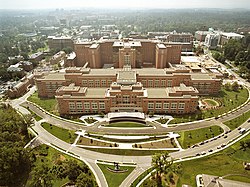NIH funding

National Institutes of Health logo
|
|
 Aerial photo of the NIH Mark O. Hatfield Clinical Research Center, Bethesda, Maryland |
|
| Agency overview | |
|---|---|
| Formed | 1887 |
| Preceding agency |
|
| Headquarters | Bethesda, Maryland, U.S. |
| Employees | 20,262 |
| Annual budget | US$30.9bn (as of 2010[update]) |
| Agency executive |
|
| Parent agency | Department of Health & Human Services |
| Child agencies | |
| Website | www.nih.gov |
The National Institutes of Health (NIH) is the primary agency of the United States government responsible for biomedical and public health research, founded in the late 1870s. It is part of the United States Department of Health and Human Services with facilities mainly located in Bethesda, Maryland. It conducts its own scientific research through its Intramural Research Program (IRP) and provides major biomedical research funding to non-NIH research facilities through its Extramural Research Program.
As of 2013[update], the IRP had 1,200 principal investigators and more than 4,000 postdoctoral fellows in basic, translational, and clinical research, being the largest biomedical research institution in the world, while, as of 2003, the extramural arm provided 28% of biomedical research funding spent annually in the U.S., or about US$26.4 billion.
The NIH comprises 27 separate institutes and centers of different biomedical disciplines and is responsible for many scientific accomplishments, including the discovery of fluoride to prevent tooth decay, the use of lithium to manage bipolar disorder, and the creation of vaccines against hepatitis, Haemophilus influenzae (HIB), and human papillomavirus (HPV).
NIH's roots extend back to a Marine Hospital Service in the late 1790s that provided medical relief to sick and disabled men in the U.S. Navy. By 1870, a network of marine hospitals had developed and was placed under the charge of a medical officer within the Bureau of the Treasury Department. In the late 1870s, Congress allocated funds to investigate the causes of epidemics like cholera and yellow fever, and it created the National Board of Health, making medical research an official government initiative.
...
Wikipedia
